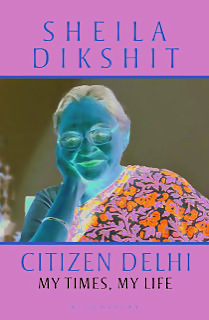
views
New Delhi: Former Delhi chief minister Sheila Dikshit’s autobiography titled Citizen Delhi - My Times, My Life gives an insight not only into her political career, but also her upbringing in the national capital.
In the book, Dikshit also touches upon her first ever election campaign and the struggles of governing a city-state like Delhi.Here’s a look at the excerpts from the autobiography:
- The BJP’s reign was rocky to say the least. In a period of five years, the party changed the Chief Minister on three occasions, from Khurana and Sahib Singh Verma to Sushma Swaraj. I saw this uncertain leadership as an advantage for us even though many well-meaning political associates were of the view that it would do me good to remember that the BJP had deep roots in Delhi from the time of its predecessor, the Jana Sangh.
- I factored that element in my mind, but I could also sense something else, the frustration of a city that did not want to be treated as a provincial place. It was the Capital and wanted to take its rightful place among the capitals of the world. At one end, those migrating from other states were coming to Delhi in search of a better and more secure life.
- At the other end was the steady growth of a middle class, which increasingly saw itself as part of a ‘globalised’ class, in a sense wanting to live in a ‘smart’ city long before the terminology took off almost two decades later! One did not have to be a clairvoyant to think along those lines. Delhi’s condition was there for all to see, the roads were in poor shape and there were only three or four flyovers to streamline the traffic flow.Wooing the Sikh Community
- In my attempt to meet as many people and communities as possible, I went to all the community occasions I was invited to — be it by Hindus, Sikhs, Muslims or Christians. The organisers would felicitate me and that would give me an opportunity to put across my point of view that Delhi was a city that welcomed people of all communities. My aim was to communicate the idea that the safety of all was a prerequisite for the development of the Capital into a modern metropolis. For that, creating a bedrock of civic governance that touched the lives of all was essential.
- As the campaign gathered steam, we noticed a response from the Sikh community, which had stayed away from our ambit in the previous few Lok Sabha elections or even in the previous Delhi state election.
- Of course, Congressmen who were facing court cases to do with the 1984 anti-Sikh violence were also kept away from the election campaign.
- My advantage, I assumed, was that I was not encumbered by political baggage. Unlike the other Delhi leaders, who were closely identified with one or another community such as Jats or Gujjars, or associated with the violence that had rocked Delhi in the wake of Indira Gandhi’s assassination, I had a neutral persona.
- Not belonging to any camp was an advantage.Being a Dilliwaali
- I considered myself a Dilliwali (with a Punjabi mother) or a UP-wali (by marriage). Moreover, the identity of a Dilliwali, which was anchored in the identity of a ‘New’ Delhi, had allowed me the space to grow as an independent woman.

- I wish they had their facts right that my marital family hailed from Unnao, which fell between Lucknow and Kanpur. To that my only reply to people was that my life was an open book — I studied in Delhi, was married in Delhi, my father-in-law had stayed in Delhi and had also been a Union Minister, my husband was posted in Delhi many times. I was in Delhi then and I was in Delhi now, and I knew Delhi and its culture more intimately than many politicians across the party divide.
- It was precisely on the strength of that identity that I now sought to appeal to Delhiites — man, woman, boy or girl.Coming into her own
- I have a vivid memory of walking down the lanes of Chandni Chowk in Old Delhi, beating a thali with a rolling pin to literally create a hue and cry about the impact of the price rise so evident in the kitchens of ordinary Delhiites. Just around that same time, the onion crisis erupted, lending wings to our campaign.
- For me, these marches were something of a personal achievement— six months ago if I had been told that I would be marching on the streets of Delhi thus, I would not have believed it. The campaign rid me of all vestiges of shyness that had been lurking within me until then. As the people of Delhi started recognising me as the ‘face’ of the Congress campaign, the BJP, and even some of my own party men, started dubbing me an ‘outsider’ from Meerut.The face-off with Sushma Swaraj
- I remember being part of a face-off with Sushma Swaraj before an audience in a programme shot close to the National Stadium near India Gate. I think that debate was an important turning point in the campaign, for Sushma dramatically announced that she would keep awake at nights to ensure that Delhi remained safe, that she would go from police station to police station at night to see if the police was vigilant.
- I replied, ‘Sushmaji, I should perhaps tell you that the police do not fall within your jurisdiction. Then why do you want to waste your time and lose your precious sleep in vain?’ That response got the audience on its feet. That day I felt Citizen Delhi.
- I remember standing at my balcony, responding to news photographers’ requests for a picture. The prospect of standing all by myself in a victorious pose seemed a bit too much, so I held my fourteen-month-old granddaughter, Tara — Sandeep and Mona’s daughter — in my arms. The house was filled with packets of mithai that well-wishers had sent.
- The newly elected MLAs thronged the house in jubilation hoping, as was natural, that I would remember them at the time of forming the Cabinet. Once everybody had left and I had the house to myself, it dawned on me that I was now in charge of Delhi. Many had voted for our party, and a certain percentage of voters had not. Unlike some parties these days, which signal voters that ‘either you are with us or against us’, I was clear that a Chief Minister needed to work for the benefit of all. Once you assume a public position, there is no scope for adopting a partisan approach.Roadblocks in governing Delhi
- I was the Chief Minister of a state that was not a full state. To set up even one school, I would need a nod from the Delhi Development Authority, a body with a misleading nomenclature, for it came under the jurisdiction of the Union Ministry of Urban Development, not the Delhi State. If I wanted to pursue power sector reforms, the approval of the Union power ministry would be essential.
- To create any new infrastructure for the people of central Delhi, I would have to engage with the New Delhi Municipal Council (NDMC), which remained outside the Delhi government’s control even though it was represented by an MLA in the Delhi Assembly. In this instance, I was the MLA from there. Apart from the NDMC, there was the Municipal Corporation, which covered the civic needs of the rest of Delhi. Although people expected me to make their lives more secure, I had no control over Delhi Police, which reported to the Union Home Ministry. Any desire to augment Delhi’s water supply would necessitate turning to neighbouring states for help.
- Moreover, almost every file had to go to the Lieutenant Governor for approval. This cumbersome process of requiring so many levels of approval was unique to Delhi. But the bottom line was that full statehood or not, to the people of Delhi, the Chief Minister, signified the face of governance. They would not have much patience for a chief minister trying to explain an underwhelming ‘report card’ by enumerating all the areas that fell outside her jurisdiction.
- There are two ways of dealing with such situations. One can throw up one’s hands and say it is impossible to perform under these circumstances or negotiate one’s way through innumerable minefields in the belief that the primary aim is to deliver on the promise of governance. I preferred the second approach.
- It was more in line with my temperament and inclination. Besides, who all could I take up cudgels against? Why, even the weather of Delhi is not its own! When it snows in Shimla or Srinagar, we shiver in Delhi. When farmers in Punjab and Haryana burn crop residues in their fields, we choke on the toxic smog it creates.Her experience as the first-time Chief Minister
- After the swearing in, the new cabinet went to the Delhi Secretariat, that is, the Old Secretariat, for a meeting with the Chief Secretary. I felt a sense of thrill as I walked into the beautiful heritage building.
- Considered by many to be the first modern building of Delhi, it was constructed a year after Delhi was declared the capital of British India in 1911. The building also functioned as the central legislature until 1927, when the Parliament building was completed. I was told that the previous government had been sanctioned an alternative for a new secretariat some time ago, in light of the fact that the gracious building was somewhat cramped. But they had dragged their feet on it.
- After a lunch meeting with the Chief Secretary, I briefly shared my views with my colleagues, emphasising that it was critical to address the obvious problems areas that affected the daily lives of Delhiites.
- Feeling disheartened with the labyrinthine process of getting approvals for policies and proposals was not an option. We needed to hit the ground running and keep communication lines open with our constituents. If everybody felt the need to have party meetings more frequently, then we could meet once a week or every ten days.
- After what seemed an unusually long day, I returned home. The day had been full of celebratory flavours, starting with euphoric Congress workers dancing to the beat of the dholak and the peekni outside the Raj Bhavan.
- But the sheer exhaustion of seven months of relentless campaigning had finally caught up with me. I put on some music to unwind. Only then did I admit to myself that I had missed Vinod and Dadda’s presence every moment of the day. I started my second day as Chief Minister, re-reading the manifesto we had brought out in response to the concerns expressed by the people of Delhi.
- They had presented me with a rare opportunity to eschew a provincial mindset and be a cosmopolitan and modern Chief Minister. It was a chance for the electorate and the elected to explore a future that was not lost in only ‘recreating’ imagined glories of the past.How Sonia Gandhi quelled rebellion within party against Dikshit
- The same well-wishers conveyed to me that my role in the Congress victory as well as my appointment as Chief Minister had come as a surprise to many Delhi Congress heavyweights. They had originally accepted my name as DPCC chief with the idea that I was bound to fail, following which status quo would prevail. I was told that previous office bearers in the Delhi Congress were especially irked.
- I did what I have always done in the face of gossip. I relegated it to the back of my mind, thinking that it was mere idle chatter and would die down soon. But instead of dying down, the ‘chatter’ assumed cacophonic proportions to become full-blown dissidence.
- On 21 April 2000, the knives came out in the open. Leaders such as Jagdish Tytler, former DPCC President, and MLa Deep Chand Bandhu, DPCC Vice President, Ram Vir Singh Bidhuri and other party legislators called a press conference in Delhi, claiming that I was corrupt and incompetent, as well as an ‘outsider’ who was unfamiliar with Delhi and its ethos.
- They announced their intention of placing their demand for my immediate resignation before Mrs Sonia Gandhi. I was informed about these developments by some MLas, but chose to keep my counsel. I have always regarded public spats with distaste.
- Three days after the press conference, the dissidents got a response from Mrs Sonia Gandhi—‘There is no question of change in leadership’.Introducing CNG buses in Delhi
- As far as the CNG issue was concerned, in the five months prior to the December 1998 election, the previous government had not stirred much on the Supreme Court order of 28 July 1998, that the entire city bus fleet should be converted to a single fuel mode, namely CNG, by 31 March 2001. Also that come April 2000, no bus more than eight years old should be on the road unless it was running on CNG.
- Converting to CNG meant creating an entirely new system that was friendly to that particular fuel. First of all, Delhi needed new CNG buses, CNG fuelling stations and technicians with the skills to retrofit existing vehicles with CNG kits. All this had to be done without causing too much dislocation in the lives of ordinary people for whom buses were a lifeline. It did not help that nowhere in the world had any city attempted a transformation like this almost overnight.
- There were no reference points before us, no experiments for us to learn from.
- To know more about the source of our CNG supply, as per the drill, I approached the then Union Minister for Petroleum and Natural Gas, Mr Ram Naik. It was decided that Delhi would get its CNG all the way from Gujarat through a 1,200 km pipeline.
- As the laity, we place our trust in experts, but a face-off between experts complicates the scenario. Questioning the recommendation of CNG fuel by the Bhure Lal Committee report, TERI’s Dr R.K. Pachauri pointed out that nowhere in the world had cities adopted CNG on such a large scale without evaluating the performance of a single bus.
- Others were of the view that the Supreme Court should have restricted itself to saying, ‘clean fuel’, without specifying a CNG fuel system. Some doubts were raised about the CNG engine’s power generation capacity as well. The questions kept coming. Wouldn’t a complete overhaul of the DTC fleet, all at the same time, result in all the buses ageing at about the same time?
- Wouldn’t the substantial investment in creating the CNG infrastructure poke a big hole in the budget, leaving the state with a huge deficit? What if something went wrong with the pipeline, starving Delhi vehicles of CNG? What would tourist buses shuttling across state borders do to refuel in another state, considering that they were limited by their single fuel mode system?
- Delhi got a breather when the Supreme Court permitted autorickshaws, taxis and buses that were more than eight years old to run on conventional fuels until 30 September 2001, provided they had placed orders for new CNG vehicles or for conversion to CNG mode by 31 March 2001. It was a nightmare.
- While DTC was phasing out part of its fleet, there were not enough CNG buses to replace them. The citizens of Delhi had to bear the inconvenience. The lack of buses hit schools hard, and school children and their parents even harder. Bus stops were overflowing.
- There were long queues lasting eight to ten hours in the few CNG fuelling stations that had become operational.
- To make matters worse, from 2001 onward there were some instances of CNG buses experiencing compressor breakdowns and cylinder bursts. A few buses fitted with CNG kits caught fire and several broke down as they were simply too old to operate with the new fuel kits. They had to be discarded. As we worked hard to allay the anxieties of the Delhiite, another problem loomed large on the horizon.
- Although Union Minister Ram Naik had had claimed that there would be an abundant supply of CNG for Delhi’s needs, closer to the deadline he admitted that it was not the case. We were caught in a cleft stick.Excerpted with permission from Bloomsbury Publishing


















Comments
0 comment